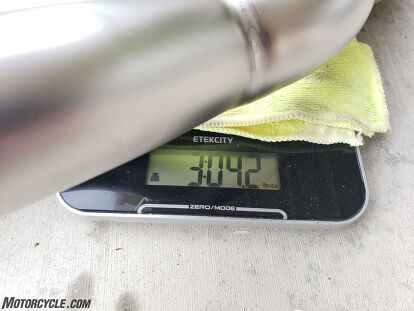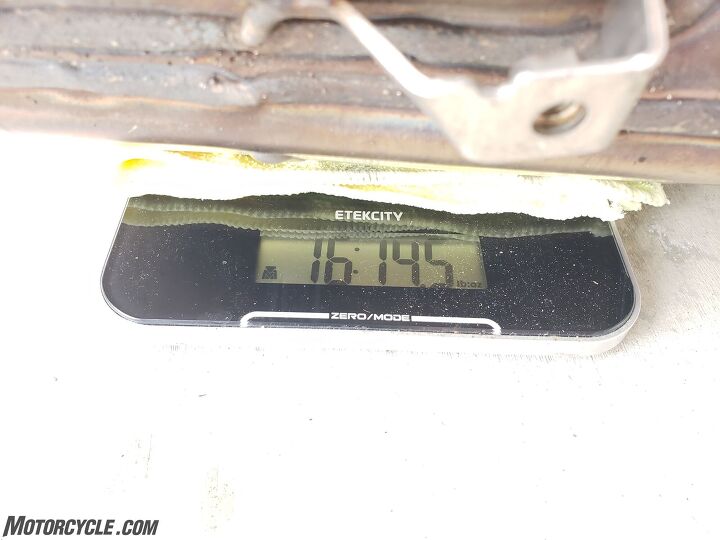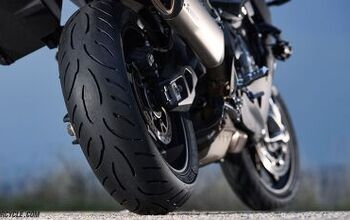Yamaha MT-10 SP Project Bike - Update 1

Everythings installed and initial impressions.
It’s been about a month since we introduced Motorcycle.com’s 2022 Yamaha MT-10 SP semi-long-term project bike. In case you forgot the premise of this whole thing, Yamaha offered us the opportunity to hang on to an MT-10 SP for an extended period of time, and since I have a soft spot for the bike, I decided to give it some tasteful upgrades to address some key weaknesses while also unleashing some trapped potential. The point here is two-fold: first is to see what the bike could do with some simple upgrades. Second is to not break the bank while doing so because otherwise, you could easily go buy one of the European competitors that would probably still spank this MT, stock.
In the past month I’ve installed the upgrades and even taken the trusty MT to the track and ridden it on the streets a little. Read on to get my take on each upgrade, ranging from ease of installation to real-world impressions.
Brakes
First up, the brakes. EBC was kind enough to send its HH sintered brake pads, which are its most aggressive. For only $80, it’s a huge value for dramatic braking performance, especially over the stock pads. Installation is super easy, too, as you just need to remove a clip, slide the old pads out, slide the new ones in, and reinstall the clip. It’s an easy five-minute job with big results. Of course, don’t forget to take some high-grit sandpaper or a Scotchbrite pad and wipe down the brake rotor before bedding in the new pads. This removes the old pad material and lets the new pads bite onto the disc.
As for the results – well, let’s just say it reinforces what we say a lot here at MO: brake pads can transform a mediocre brake setup. The initial bite is immediately stronger than the stock pads, which is a big complaint with the soft standard pads. And thanks to that strong initial bite, the overall braking power feels more robust, too. The harder I pull the lever, the more eager the bike is to slow down. If I were to nitpick, I’d say the Brembo master cylinder is now the weak link, as there feels like a tiny bit of play in the lever, different from air in the lines. But overall, this upgrade is an absolute must for any MT owner, in my opinion. If you have the standard MT-10 and not the SP, I’d suggest changing the pads first, then replacing the rubber lines for steel.
While they were at it, EBC sent an unsolicited pair of its XC contour fully floating brake rotors that are a direct replacement for the stockers. These run approximately $250 per side or about $500 for a pair like you need on the MT-10. The fully floating option is nice, and they do weigh a few grams less than the stock discs. Installation, too, is really easy. Just unscrew the old and replace it with the new (don’t forget the thread locker!)
Unlike the brake pads, however, the difference with the XC discs wasn’t as noticeable over stock. Sure, the fully floating feature is nice because it ensures constant and consistent contact with the brake pads even as the temperature rises, but in reality, I would have been hard-pressed to tell the difference. So, as nice as EBC was to send this with the set of pads, when it comes to bang for the buck, I’d opt to spend the money elsewhere.
Leo Vince Cat-Delete Midpipe
If keeping your motorcycle 100% road-legal is of utmost importance to you, then stop reading this section now.
For the rest of you, the Leo Vince cat-delete midpipe (and others like it) is a cheap and simple upgrade that not only frees up some power and awakens a rumbling (but subtle) growl from the engine, but it also sheds over 13 lbs from the bottom of the bike. I like it because it also lets you keep the stock silencer, so you’re not forced to spend additional money to buy a slip-on exhaust if you don’t want to. Not to mention, keeping the stock silencer retains the sleeper appearance and a modest exhaust note at idle.
Installation of the midpipe is simple – it’s removing the stock midpipe/cat that’s a bit of a process. There are a series of bolts to loosen or remove, some of which reveal brackets that are primarily to support the heft of the stock cat. Most of these bolts and brackets won’t be reused. You also need to loosen the O2 sensors and place them out of the way (more on that in a minute). Removing the stock silencer gives you space to slide the stock cat off the exhaust headers. After that comes removal of the push/pull cables used for the Yamaha EXUP valve, as the valves and the cables won’t be needed anymore. This requires loosening the tension at the EXUP valve itself before removing the cable, then you can have the necessary slack at the servo motor located under the seat to undo the cabling up there.
Now, as for the servo motor itself; at this point, you can disconnect and remove it and save a little bit of weight, but as Nate Phipps, the ECU flashing wizard at 2 Wheel DynoWorks informed me, “the ECU wants to see voltage from every emissions system, regardless if they’re functional or not, in order for cruise control to work.” Since this bike is still ridden on the street, and not exclusively at the track, cruise control is important, and I kept the servo motor connected and in place.
As for the O2 sensors, these also aren’t needed anymore, and the Leo Vince midpipe has plugs you can screw into the bungs to cap them off. However, I decided to keep them in place for a couple of reasons. First, removing them meant tracing the wires back underneath the fuel tank, which means lifting or removing the tank. Frankly, I didn’t feel like taking the tank off. But second, and more importantly, removing them would disable cruise control for all the same reasons as it would with the EXUP valve. So, they stayed.
With everything loose and cables gone, some wiggling and muscle slides the cat right off. Installing the Leo Vince midpipe couldn’t be easier, especially as all the hardware is provided. You put the hose clamps in place, slide it onto the exhaust header, line the support tab in the middle with the existing bracket on the bike, place the stock silencer back on, line up all the bolt holes, and bolt everything back together. Done. As for impressions, it’s best to save that for the final upgrade…
ECU Flash
Tying this whole thing together is the ECU flash performed by the aforementioned Nate Phipps at 2 Wheel DynoWorks. Earlier I called him a wizard, and that’s because he really is when it comes to this ECU flashing business. He knows these Yamaha ECUs inside and out. By his own count, he’s flashed over 100 FZ/MT-10 ECUS through the years. Needless to say, he was a great guide for this project.
Actually, Phipps flashed the ECU twice. The first time was when the bike was 100% stock, including the factory catalytic converter. Even in stock trim, there is performance to be had, and Phipps found it. In case you’re curious, here’s what one of his ECU flashes entails:
- Custom IAP Fuel Maps (Specific to your exhaust system)
- Custom TPS Fuel Maps (Specific to your exhaust system)
- Custom Ignition Timing Maps
- Custom Electronic Throttle Valve (ETV) Maps
- Adjusted Fan Temperature
- Disabled Evap / Purge Valve Fault Code
- Disabled Stock O2 Sensor Fault
- Disabled Deceleration Fuel Cut
- Disabled EXUP Fault Code
- Disabled PAIR Valve / AIS Fault Code (Aftermarket exhaust only)
- Disabled Top Speed Limiter
- Custom Engine Braking Control Maps
In addition, when I rode the MT-10 SP at the track in stock form, I mentioned how the autoblip downshifts were very hard to engage, requiring me to space them out farther than I wanted. I suspected this was Yamaha’s way of saving the engine from over-revving and Phipps confirmed it when he mentioned “there is a 250-rpm buffer built into the ECU to prevent the bike from exceeding the rev limiter when downshifting. This type of buffer is actually present in every ECU/bike that comes with an autoblipper from the factory. It’s simply there to prevent engine damage.” When he followed up with, “We can certainly increase the rev limiter very safely by 500 rpm, which should massively ease this issue!” I clearly got my hopes up.
Similar to changing jets on a carburetor to affect performance, a flash can change the EFI fuel mapping to get the air/fuel ratio where it should be. That’s a relatively simple thing to meter for on a dyno. The real magic with ECU flashing comes down to ignition timing, and as Phipps revealed to me, “for this specific ECU I had to advance and retard the timing in places.” Exactly where, and how much he either went high or low, is the secret sauce most tuners keep close to their chest.
Replacing the cat with the midpipe meant there was now more air being introduced to the engine. If left alone the bike would have been running lean. So, the ECU was sent back for another flash to add more fuel and bring the AFR back in line. As for the results, take a look at the dyno graphs below.
Before getting into the results, we first need to establish that these numbers appear to be low. Multiple sources have told me that even a stock MT-10 should be in the low 130 horses at the rear wheel and get up to 150-ish horses after the mods. I’m not exactly sure why these numbers are reading low other than operator error (me), though I put my own personal bike on the same dyno and it appeared abnormally low, too. Maybe we’re dealing with a really stingy dyno.
Nonetheless, if a single horsepower and torque number are all you’re looking for, you’re partially missing the point. Let’s look at the overall graphs, starting with the stock MT-10. The lull in the midrange is noticeable both on the street and the track, though we tend to ignore it because it still pulls well enough. Look at both the horsepower and torque curves with just a flash and we can see the dip flattens out significantly over stock – a difference that’s very much noticeable, as second-gear roll-on wheelies are basically the norm now.
Move to the midpipe and flash, and even though the horsepower curve is marginally better than just the flash in the midrange, look at the torque curve and the midrange difference is big compared to just the flash and massive compared to the stock bike. This is, without a doubt, something you can feel from the saddle.
The other big difference comes at the end of the graph. You can clearly see the stock bike signing off around 9500 rpm before hitting its rev limit around 11,000 rpm. After the flash it’s clear as day to see the increased rev limit Phipps opened up, and with that comes another massive gain in power and torque. Personally, I’m not putting much weight on the minor differences in peak power and torque. I’m much happier with the overall graphs, not to mention the super smooth throttle response.
On the street and on track, these differences are abundantly clear. Around town, there’s immediate power to overtake others and be even lazier with shifts, while on the racetrack the extra midrange and top end bursts you out of slow corners and shows what the bike can do on the straights. Equally as nice is the uncorked sound the crossplane crank makes as you twist the wrist. The subtle growl at idle transforms to a raucous bark once the bike gets all riled up. It’s music to the ears.
Negatives
This isn’t to say the experience has been all roses and sunshine, though (but it mostly has). There have been some negatives so far. First, raising the rev limit did nothing to solve the slow and clunky autoblip downshifting. I’m led to believe it’s just the way it works and the shift sensor isn’t as sophisticated as others. In the meantime, I’ve resorted to using the clutch if I need to bang off some quick downshifts. It’s disappointing considering that’s the whole point of an autoblipper.
Maybe the real negative here is the amount of gas this bike drinks now after the ECU flash. More air from the midpipe means more fuel, and over the course of eight sessions (which is every single one) at Auto Club Speedway with Fastrack Riders, I blew through my spare 5-gallon fuel jug and had to beg and borrow about two or three more gallons to finish the day. That’s never happened to me before. As of press time, I’m still working through a full tank on the street, but after about 100 miles, the fuel gauge is showing a little more than a quarter full.
Overall First Impressions
Downshifts and fuel consumption aside, I’m extremely happy with the MT-10 SP so far. These three simple mods – brake pads ($80), midpipe ($290), and ECU flash ($350) – have only set us back $720, but have completely transformed the bike (don’t count the brake discs since they’re not necessary). On the street, it’s a docile commuter when you want it to be (thanks, cruise control!), but is ready at a moment’s notice for the weekend canyon blast. Then it can also pull double duty and surprise people at a trackday, too. The power is healthy enough to keep an ear-to-ear grin on your face, the crossplane crankshaft sound will keep you coming back for more, and the standard traction/wheelie/slide controls will protect you from yourself if you get a little too trigger-happy.
Also impressive is the Öhlins electronic suspension. I’ve purposely only fiddled with the automatic settings (and not the manual settings) to see how it would react to different road and track conditions, and simple button presses make a difference – usually for the better. The only hiccup I’ve noticed is extremely bumpy roads can make the suspension lag as it figures out the best way to cope.
All that’s left to do now is to continue to put miles on the bike to see if the honeymoon phase lasts or if there’s a chink in the armor that’s yet to be exposed. I’d still like to put a larger windscreen on it, but global supply issues have made one harder to come by than I expected. And if this thirst really is dramatic, that could potentially be a drawback, too. Who knows. Maybe it’s time to see if this bike could give its Euro counterparts a run for their money.
Become a Motorcycle.com insider. Get the latest motorcycle news first by subscribing to our newsletter here.

Troy's been riding motorcycles and writing about them since 2006, getting his start at Rider Magazine. From there, he moved to Sport Rider Magazine before finally landing at Motorcycle.com in 2011. A lifelong gearhead who didn't fully immerse himself in motorcycles until his teenage years, Troy's interests have always been in technology, performance, and going fast. Naturally, racing was the perfect avenue to combine all three. Troy has been racing nearly as long as he's been riding and has competed at the AMA national level. He's also won multiple club races throughout the country, culminating in a Utah Sport Bike Association championship in 2011. He has been invited as a guest instructor for the Yamaha Champions Riding School, and when he's not out riding, he's either wrenching on bikes or watching MotoGP.
More by Troy Siahaan



















































Comments
Join the conversation
Hi Troy! I already did the decat mod(used an aliexpress titanium midpipe) and still stock exhaust but might change it soon. Brake pads i might do it too, i found out the brake pads while new sucked but after a few miles it got better, still not as good as my 2013 rsv4 factory or friend’s sfv4s.
For ecu flash, what do you think of brentune? So I’ll just buy the handheld tuner instead of sending my ECU from Philippines to the US?
Also, when is part 2 coming? Thanks
This is a great series that Motorcycle.com is doing! Will there be future updates?